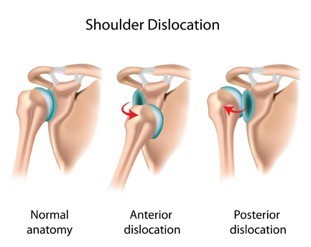A joint dislocation is a separation of 2 bones where they meet at a joint. Joints may dislocate when a sudden impact causes the bones in the joint to shift out of place. Since the shoulder is the most mobile joint in the body and has such a wide range of motion, it is more likely to dislocate than any other joint in the body. Dislocations are among the most common traumatic injuries affecting the shoulder. A partial dislocation (subluxation) occurs when the head of the upper arm bone (humerus) is partially out of the socket (glenoid). A complete dislocation occurs when the humerus is completely out of the socket. Both partial and complete dislocation cause pain and unsteadiness in the shoulder. With most shoulder dislocations, you will feel the humerus coming out of the socket, followed by, pain, inability to move the arm and an abnormal appearance of the shoulder. Other symptoms include, swelling, numbness, weakness and bruising in the affected shoulder. Sometimes dislocation may tear ligaments or tendons in the shoulder or damage nerves. The shoulder joint can dislocate forward, backward, or downward. A shoulder dislocation most often occurs during contact sports, but everyday accidents such as falls can also cause the joint to dislocate. A dislocated shoulder usually requires the assistance of a health care professional to guide the joint back into place. A shoulder dislocation requires immediate medical attention, especially if you have numbness in your arm or hand, discoloration of arm or hand, and/or cold feelings in your arm.
